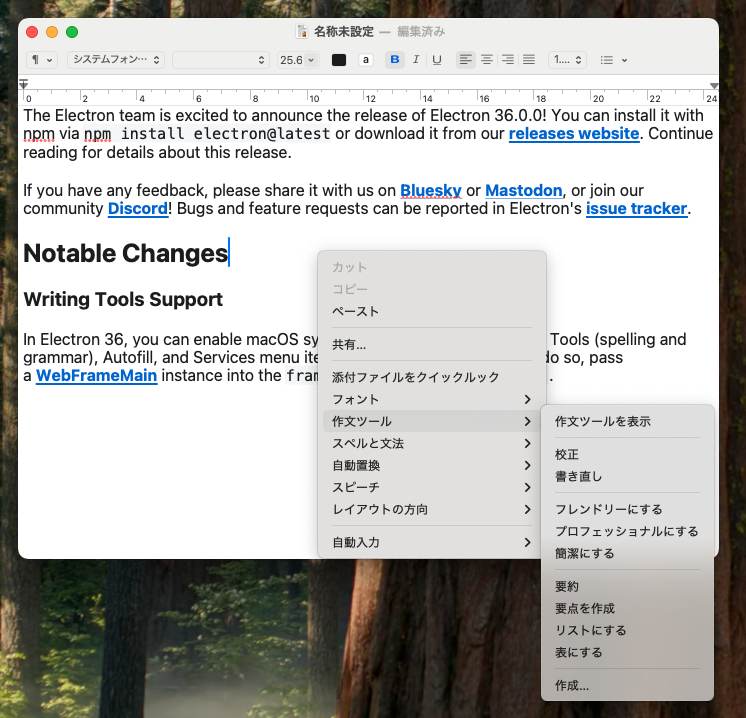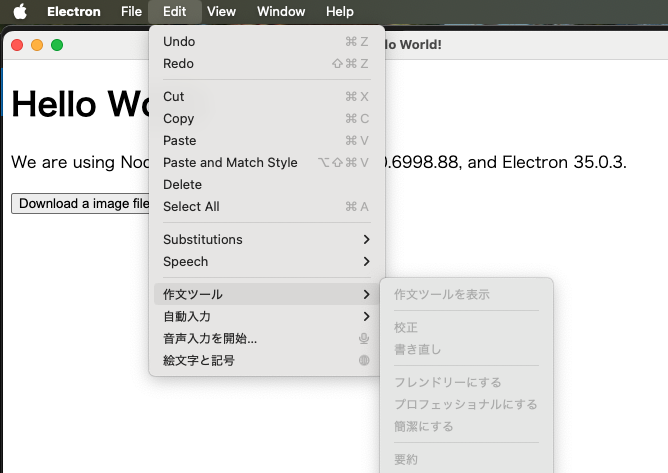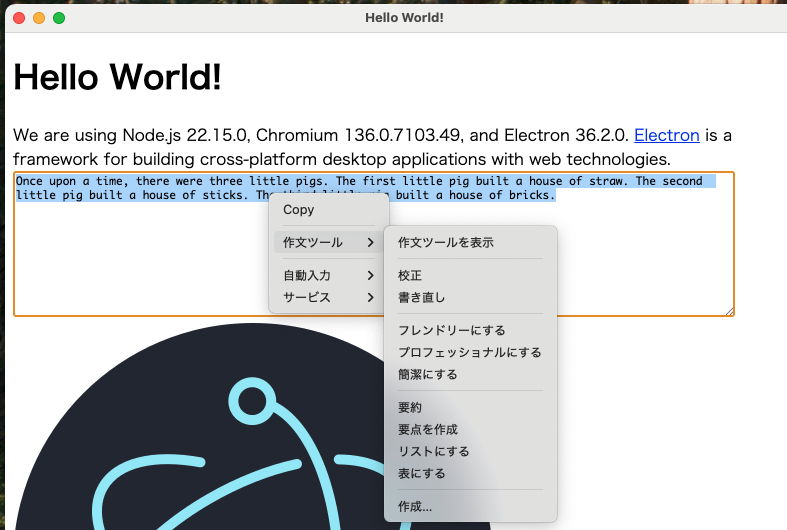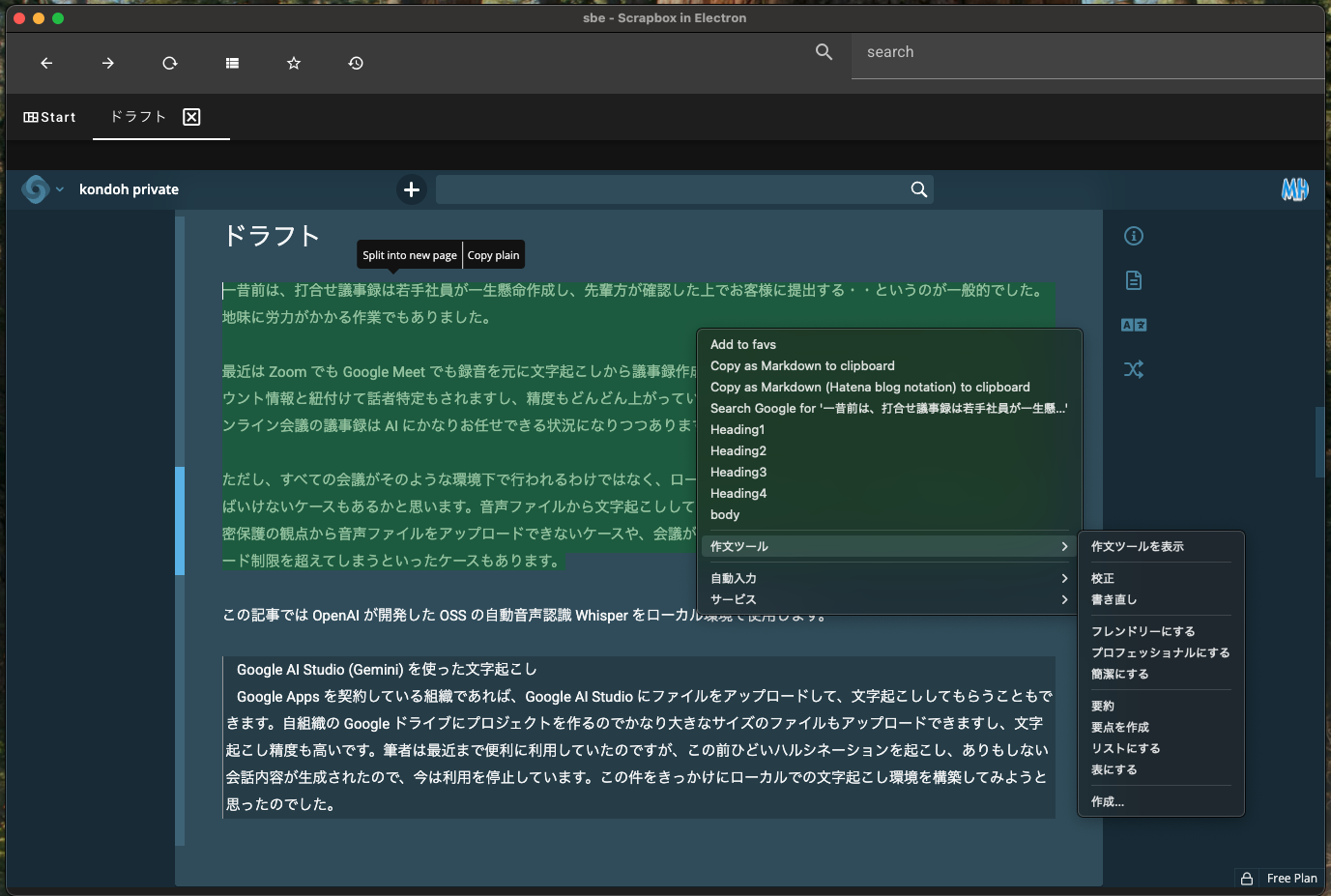Using macOS Apple Intelligence Writing Tools from an Electron App
Back to TopTo reach a broader audience, this article has been translated from Japanese.
You can find the original version here.
Introduction
#Electron 36.0.0 was released at the end of last month.
The highlight feature is that you can now use macOS Apple Intelligence’s Writing Tools via the context menu.
As mentioned later, you can also use Writing Tools from the application menu in the menu bar in previous versions of Electron rather than via the context menu. You only need to enable Apple Intelligence; there is no need to modify your app.
What is Apple Intelligence
#Apple Intelligence is an AI platform provided on Apple’s devices, available from iOS 18.1, iPadOS 18.1, and macOS Sequoia 15.1 onward. It also supports Japanese. When you enable Apple Intelligence, you can use image generation apps, Siri can integrate with ChatGPT to become smarter, and as a general-purpose feature, you can use Writing Tools in regular applications[1].
You enable it from Settings under “Apple Intelligence & Siri”[2].
Once Apple Intelligence is enabled, you can select text in any native application that displays or edits text and invoke Writing Tools features from the app’s “Edit” menu or the context menu to summarize or proofread the text.
Here is how you invoke Writing Tools in the TextEdit application. You can call the desired feature from the “Writing Tools” submenu in the context menu.
Writing Tools Support in Electron’s Context Menu
#The feature request to enable Writing Tools in the context menu was discussed in the following issue.
The feature released in Electron v36 appears to have been implemented by the following PR, which adds OS-level menu item support.
This is enabled by an option that accepts a WebFrameMain class instance when building menus.
As mentioned at the beginning of this article, if Apple Intelligence is enabled, you can use Writing Tools from the menu bar in existing Electron apps without making any changes. What was supported this time is the use case where you want to use Writing Tools from the context menu on text selected in a TextArea or similar.
Enabling Writing Tools in an Electron App’s Context Menu
#Here’s a sample showing how to enable Writing Tools in the context menu of a basic Electron app that simply loads web content in the main window.
For information on how to display a context menu in an Electron app, see the following article:
What you do is, in the normal context menu display, get the focusedFrame property (an instance of WebFrameMain) from WebContents, and specify it in the frame option of contextMenu.popup. See the comments in the code for details.
import { app, BrowserWindow, Menu } from 'electron';
import path from 'node:path';
const __dirname = path.dirname(fileURLToPath(import.meta.url));
let mainWindow;
app.whenReady().then(() => {
createWindow(); // Create the main window
// Context menu handling
mainWindow.webContents.on('context-menu', (e, params) => {
// Get the WebFrameMain class of the main window
const focusedFrame = mainWindow.webContents.focusedFrame;
// Build the menu template
const menuTemplate = buildMenuTemplate(params);
// The visible attribute should normally be handled by Electron, but it hasn’t been recently, so we filter it ourselves
const visibleItems = menuTemplate.filter(item => item.visible);
// Build the context menu
const contextMenu = Menu.buildFromTemplate(visibleItems);
contextMenu.popup({
window: mainWindow.webContents,
frame: focusedFrame, // Set the instance of WebFrameMain
});
});
});
// Create the main window
function createWindow() {
mainWindow = new BrowserWindow({
width: 800, height: 600,
webPreferences: {
preload: path.join(__dirname, 'preload.js'),
}
});
mainWindow.loadFile('index.html');
}
// Build the menu template
function buildMenuTemplate(params) {
const menuTemplete = [
{
label: 'Copy', // Copy text (using role)
role: 'copy',
visible: params.selectionText.trim().length > 0
}
];
return menuTemplete;
}
Result of running this. From the “Writing Tools” menu you can pass the app’s text data to Writing Tools and get results. It works particularly well in text areas.
If you run the above code on Windows, nothing special happens except that the specified menu is displayed, so it seems you don’t need to detect the platform and write separate code.
I also integrated this into my Scrapbox app.
Since Scrapbox’s edit screen is different from a regular text area, the “Replace” function did not work properly[3].
Conclusion
#Electron allows you to build cross-platform apps, and it’s great to be able to incorporate convenient OS-native features into your app. The integration of each OS with generative AI will continue to progress, and Electron apps will also become more convenient in line with platform evolution.






